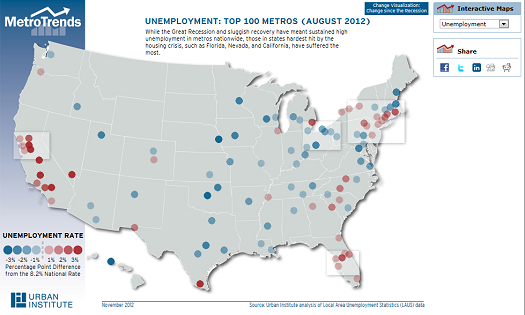Allocating Monies Where Unemployment Is Highest
Posted: November 15, 2012 Filed under: Job Market and Labor Force, Shorts 1 Comment »As Congress debates how to unwind from all the debt it is accumulating, it continues to face high unemployment around the nation. One possible deficit-reducing approach is to provide greater assistance or revenue sharing to those regions, or people in the regions, most suffering from high unemployment, while reducing some across-the-board supports.
To examine variation in unemployment, I would like to draw attention to some of the interesting interactive graphs available from Urban Institute’s MetroTrends web site. The graph below looks at unemployment in the top 100 metro areas in the United States. By clicking on a city, you can look at the unemployment rate going back to 2000 or compare unemployment between two cities.
Below is a screenshot; the interactive graph can be found at http://datatools.metrotrends.org/charts/metrodata/LAUSMap_files/LAUSMap.cfm.



It would be interesting to try a new approach, where instead of foisting support for the unemployed on the government, employers can, as an offset to their taxes, pay the recently unemployed a sum between full severance and minimum wage to attend some type of training or counseling (even if they were fired for a reason), as well as money for a refundable child tax credit of $500 per child per month. At some point, the employee would be rehired or hired by someone else. The training should be no picnic, so people don’t spend their entire lives doing it.